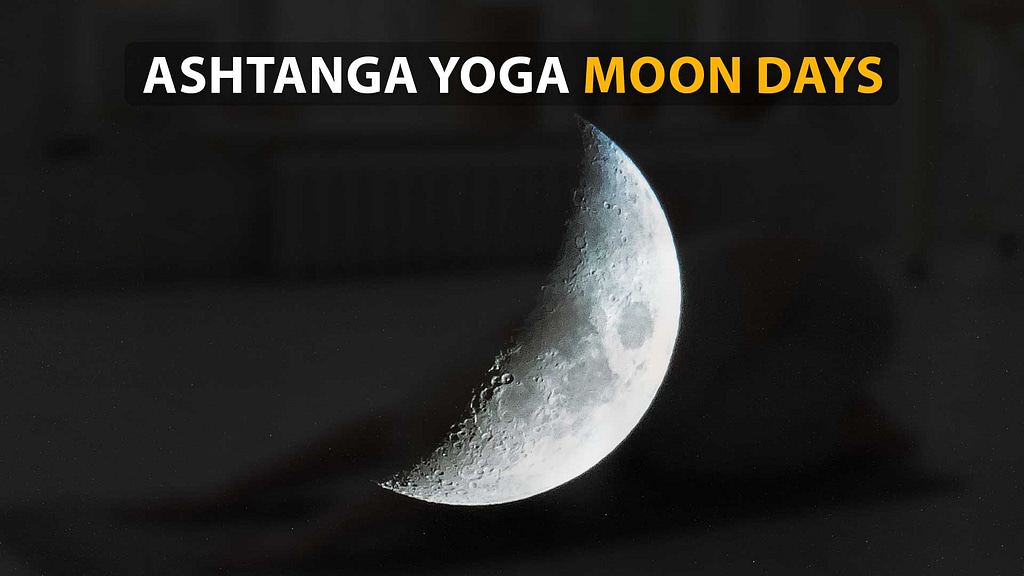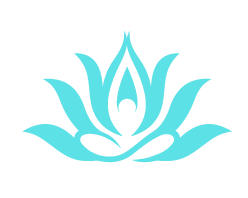Ashtanga Yoga Moon days – How Can We Calculate in 2024

Ashtanga Yoga Moon days
In the Ashtanga Yoga practice, the days of the full moon and the new moon are yoga holidays. About 70% of a person’s body is water, so just like the ocean, we are also affected by the moon’s phases. Both the sun and the moon pull on the earth with their mass.
What are moon days in Ashtanga Yoga?
Moondays, often referred to as “Lunar Days,” are recognized as rest days in the Ashtanga yoga tradition. The practitioner takes a break from their normal Ashtanga yoga practice during this.
Ashtanga Yoga has the unique and distinctive custom of preventing practice on “moon days,” or the days of the full and new Moon. On the days of the Full Moon and the New Moon, people observe moon days.
Why are moon days important in the Ashtanga yoga tradition?
The concept that the Moon significantly impacts the Earth and its residents, including humans, is the foundation for Ashtanga yoga’s moon-day practice. Some believe that Our physical, mental, and emotional states are affected by the energy shifts because of the full Moon and new Moon.
So, it is assumed that Ashtanga yoga will enable the body and mind to relax and recover. On certain days, resting from the intense physical practice
Ashtanga yoga practitioners should perform mild and restorative practices such as meditation, pranayama (breathing techniques), or light stretching on moon days compared to severe physical activity. This enables the body to recover from the practice from the previous day and be ready for the following exercise.
Origins of moon days philosophy

The ritual of recognizing and following moon cycles, which has been a part of Indian culture for thousands of years, is the foundation of Ashtanga yoga’s Moon days practice.
It is said that Lord Chandra, who is related to the Moon in Hindu mythology, is believed to impact people’s emotions, feelings, ideas, and behaviors.
The shift between the two phases generates a slight change in energy that can affect our physical, mental, and emotional conditions. The full Moon and new Moon are thought to be times of heightened energy.
The Ashtanga Moon Days are based on an old Indian custom, just as Sundays used to represent a western God’s day of rest. Taking a break from work every “blue moon,” or every new and full Moon, was customary in ancient India.
This tradition has been included in the yogic philosophy that Ashtangis believe in. It has developed into a special day after six days of practice every week, When we may rest our tired bones and muscles for a little while.
And before returning to the tapas principle, we aim to develop real and everlasting yoga inside.
This day of the Moon was regularly utilized for spiritual practices like devotion or prayer. In the yogic culture, Moon days maybe when we concentrate on the other two pillars of Kriya Yoga.
Read:
Can You Learn Ashtanga Yoga At Home? – Complete Guide In 2023
Sri k Pattabhi Jois adds moon days to Ashtanga yoga

Sri K. Pattabhi Jois, the Ashtanga yoga system’s creator, popularized observing Moondays in Ashtanga yoga. Jois was greatly inspired by traditional Indian culture and philosophy as he studied under the well-known Indian yoga master Krishnamacharya.
Jois thought it was essential for Ashtanga yoga practitioners to relax on Moon days. As a way to honor moon cycles and help the body and mind recover from the practice’s demanding physical and mental requirements,
Moondays cycle, according to Indian philosophy,s the term “tithi.”
The word “moon day” is a rough translation of the Sanskrit term “tithi” in India, the origin of yoga. It should be translated as “lunar phase” rather than “moon day.” The time it takes for the Moon to move 12° across the sky is called a tithi.
As a result, a whole lunar cycle has 30 tithes (or lunar phases). Each tithi has a different length and starts at a different time of day because of many factors, including the curved route of the Moon’s orbit. The time between these varies between 19 and 26 hours.
The 15th and 30th tithis of this Indian astrology (Jyotish) system are roughly referred to as the full and new “moon days,” respectively.
How can we calculate moon days?
First, when the Moon makes its orbit around the Earth, it is in the middle of a 30-day cycle. The actual duration of the journey, from one “New Moon” to the following, is 29.53 days.
Read:
Does Ashtanga Yoga Help You Lose Weight? – A Comprehensive Analysis In 2023
How do yogis spend their full Moon?

Some yogis like to use Moondays as a chance to assess their routine. Make resolutions for the next lunar cycle. It could be maintaining a focus on themselves or expressing thanks for the improvements in their practice.
Together with regular practice, some Ashtanga yoga communities and studios may host special occasions or get-togethers on Moon days, such as team meditations or seminars on yogic theory or anatomy.
The practices that yogis engage in on moon days eventually depend on their practices and the customs of their particular yoga group. The philosophy of respecting the body’s, mind’s, and universe’s natural cycles is still at the core of the focus on rest and meditation.
Ashtanga moon days for western yogis
Western yogi trainees often become confused by the alien cultural patterns they encounter when they inspiredly try to follow the teachings and principles of the yogi’s path. They sometimes mistakenly add their inner culture to what they perceive as they try to understand it all, strengthening the confusion.
Observing Moondays in Ashtanga yoga can be a helpful approach for Western yogis. It can help them to advance their practice and connect with the historical origins of yoga.
we can calm down and relax in moon days, which is important in today’s fast-paced society when we are sometimes completely overwhelmed and overworked.
Why does Ashtanga not practice on moon days?
It is a way to respect the way nature works. Also, Indian astrology says that we shouldn’t do certain things on moon days because the moon’s movements significantly affect our energy.
At the end of an exhale, when the force of prana is at its strongest, is when the new moon’s energy is at its strongest.
It’s a way in which the prana contracts and moves downward. It’s a moving force that makes us feel calm and grounded, but it can also make us feel heavy and tired.
And also you Can not practice Ashtanga on a full moon just because Ashtanga is one of the most challenging types of yoga, so yogis don’t do it on the full moon.
This is because the risk of getting hurt is higher, so they use the full moon as a day to rest. During this moon phase, you should do all other kinds of yoga.
Do Ashtanga moondays’ effects proven by Science?
Although Ashtanga Moon Days are founded on customs that Ashtanga Vinyasa yoga practitioners have followed for many years, there is no thorough scientific research on their benefits.
After observing these rest days, many practitioners report feeling more rested, renewed, and energized.
Read:
Can Ashtanga Yoga Build Muscle? – Myth Or Reality? 2023
Conclusion
Overall, Ashtanga yoga practitioners should respect and follow this tradition to keep harmony and balance in their bodies and minds. Ashtanga Moonday is a huge part of Ashtanga Yoga practice.
Ashtanga yoga moon days calendar 2023

January
Friday 6th – full
Saturday 21st -new
February
Sunday 5th- full
Sunday 19th-new
March
Tuesday 7th -full
Tuesday 21st – new
April
Thursday 6th – full
Thursday 20th – new
May
Friday May 5th – full
Friday 19th – new
June
Saturday 3rd – full
Saturday 17th- new
July
Monday 3rd – full
Monday 17th- new
August
Tuesday 1st – full
Wednesday 16th- new
Wednesday 30th – full
September
Thursday 14th – new
Friday 29th- full
October
Saturday 14th – new
Saturday 28th – full
November
Monday 13th – new
Monday 27th – full
December
Tuesday 12th – new
Tuesday 26th – full
FAQ’s: Ashtanga yoga moon days
Q: How many days a week should I do Ashtanga?
Six days a week.
Q: How do 3 moon cycles work?
There are four main phases of the Moon: the new Moon, the first quarter, the full Moon, and the last quarter, also called the third or fourth quarter. During these phases, the Moon’s ecliptic longitude is at an angle of 0°, 90°, 180°, and 270° to the Sun, as seen from the centre of the Earth.
Q: Which Moon is the strongest?
Since it is the celestial body closest to us, the Moon strongly affects our mental bodies. The energy we can get from the Full Moon is the strongest, and the point we can get from the New Moon is the next strongest.
Q: How does a moon bath work?
Moon swimming is a traditional way to help people stay cool in the summer. It involves spending time in the moonlight. It is also thought to help people relax, deal with worry and anxiety, and even help a woman’s period.
video guide
Read Also
- Why Is Ashtanga Yoga Considered To Be The Most Difficult? – Complete Guide 2023
- Ashtanga Vs Hatha Yoga – Which Form Of Yoga Is Best In 2023
- Ashtanga Opening And Closing Mantra – Complete Guide 2023
- What Is The Ashtanga Yoga Of Patanjali? A Comprehensive Guide In 2023
- What Is Ashtalaksmi Yoga? – What Does Ashtalakshmi Yoga Mean On A Birth Chart?
- What Is Magnetic Pull During Meditation? – What You Need To Know In 2023






